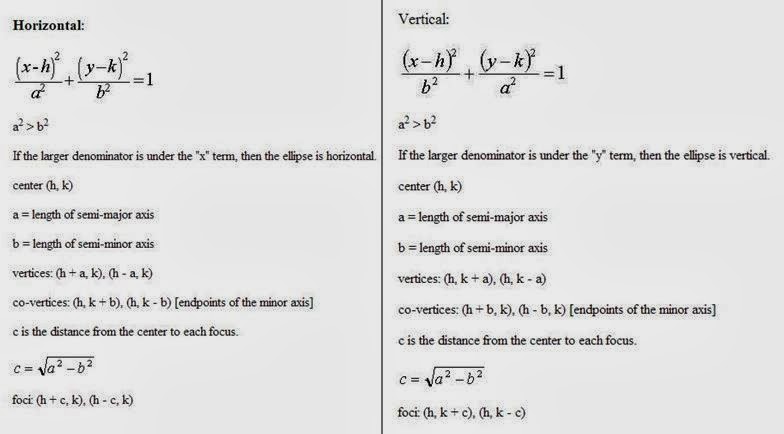RWA: Ellipse Conic Section
- Definition: "The set of all points such that the sum of the distance from two points is a constant." (http://www.lessonpaths.com/learn/i/unit-m-conic-section-applets/ellipse-drawn-from-definition-geogebra-dynamic-worksheet)
- Description:
- Algebraically:
(http://www.clausentech.com/lchs/dclausen/algebra2/ellipses.htm)
Two different ways the equation can be written, both producing an ellipse. How each is read and graphed will be explained in more detail later.
- Graphically: Ellipse is an oval-shaped graph that has a major solid axis and a dotted minor axis. There is a focus graphed inside the ellipse and the center lies, obviously, in the center. Refer to the picture to figure out whether the ellipse will be horizontal or vertical. Points are also graphed on the endpoints of both axis.
- Key Features:
- http://media.wiley.com/Lux/94/219994.image1.jpgHere are all the key features of an ellipse. The center is not listed here but it is obviously the center and is found by the simple h.k rule from the equation, just take the h,k value and the opposite signs of those numbers are your center. The way you find the vertex is taking the square root of the bigger value or the "a" value and adding it and subtracting it either the h or k value whether its horizontal or vertical, view the previous image to better understand. The minor axis is found the same way but with the smaller "b" value. Both of these are found as the denominators and have axis that cross through them all the way to the center. The axis that crosses the vertex is usually solid and is called the major axis. The one that crosses the co-vertex is called the minor axis and is usually dotted. For more information visit http://www.clausentech.com/lchs/dclausen/algebra2/ellipses.htm .
- Foci and Eccentricity: The foci are found by finding the c value through the equation a^2-b^2=c^2 where a must be greater than b. The value of c is then added and subtracted to either the h or k value in the same way the a value was added and subtracted. Foci dictate how circular the ellipse is, if it is closer to the center then it is more circular. The eccentricity or the value of c/a will always be less than one for an ellipse.
- Further Help on Graphing an Ellipse:
3. Real World Application: Probably the most common occurence of ellipses is in space. The way gravity works makes orbit travel not in a perfect circle, but in a fixed ellipse.
(http://britton.disted.camosun.bc.ca/elliorbit.GIF)
One perfect example of this fixed path is Halley's Comet, which was discovered by Edmund Halley. "Halley's Comet takes about 76 years to travel abound our sun. Edmund Halley saw the comet in 1682 and correctly predicted its return in 1759. Although he did not live long enough to see his prediction come true, the comet is named in his honour."(http://britton.disted.camosun.bc.ca/jbconics.htm) Halley's Comet chooses this path in a way that it cuts through space like a conic section would normally do. Here is a video describing the comet in full detail and a better view of it's ellipse path.
One perfect example of this fixed path is Halley's Comet, which was discovered by Edmund Halley. "Halley's Comet takes about 76 years to travel abound our sun. Edmund Halley saw the comet in 1682 and correctly predicted its return in 1759. Although he did not live long enough to see his prediction come true, the comet is named in his honour."(http://britton.disted.camosun.bc.ca/jbconics.htm) Halley's Comet chooses this path in a way that it cuts through space like a conic section would normally do. Here is a video describing the comet in full detail and a better view of it's ellipse path.
4. Works Cited:
- http://www.lessonpaths.com/learn/i/unit-m-conic-section-applets/ellipse-drawn-from-definition-geogebra-dynamic-worksheet
- http://www.clausentech.com/lchs/dclausen/algebra2/ellipses.htm
- http://www.dummies.com/how-to/content/how-to-graph-an-ellipse.html
- http://media.wiley.com/Lux/94/219994.image1.jpg
- http://britton.disted.camosun.bc.ca/jbconics.htm
- http://britton.disted.camosun.bc.ca/elliorbit.GIF
- http://www.youtube.com/watch?v=5nxT6LQhXLM
- http://www.youtube.com/watch?v=C8zV1xiGqf4


No comments:
Post a Comment